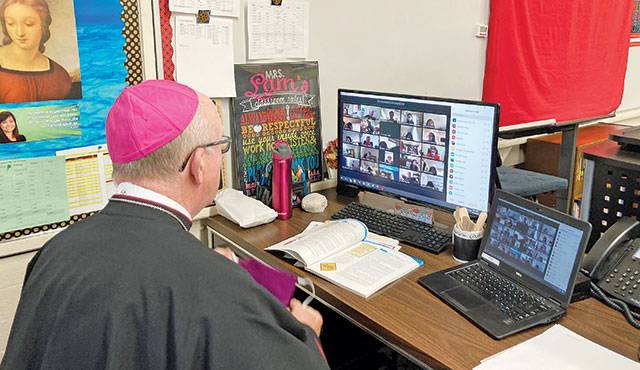As the calendar turns from 2020 to 2021, Diocese of Orange Catholic Schools reflect on both the challenging year that was and the hopeful new year ahead, with pride in what they were able to achieve in the face of the COVID-19 pandemic.
“I just feel so proud of what we’ve been able to accomplish throughout this crisis,” says Superintendent of Diocese of Orange Catholic Schools Dr. Erin Barisano. “We’ve been able to not only get our kids back for in-person instruction, but here we are at the peak, and we’re still in school and our teachers are still safe.”
After implementing distance learning across the diocese in the span of a few days last March to welcoming students back to campus at the start of the new school year in September, Barisano remains confident that the diocese’s commitment to Catholic faith formation, academic excellence and service to others remains strong.
“It makes me so proud that we’ve been able to stay the course and remain committed to the mission of Catholic education here in the diocese,” says Barisano.
While some families initially opted to stay in a distance-learning format in September, schools saw the number of distance learners decrease over the fall months, signifying that once parents observed the school’s health and safety protocols in action, they became more at ease with sending their students to campus for onsite instruction. As a support to this, the Catholic schools’ district website maintains a COVID-19 dashboard to provide transparency.
“The transmission rate at the schools is very low…because of the health and safety protocols that are in place,” says Associate Superintendent Dr. Denise Valadez.
In the area of faith formation, each school has continued to offer a number of experiences for students and families, albeit in a variety of formats. Virtual rosaries, weekly outdoor Mass with both livestream and limited in-person attendance and Eucharistic ministers visiting classrooms to distribute communion are just a few of the ways schools are fostering faith in their communities.
“Our principals are very adamant about not making any sacrifices to their religion program and what they are offering as far as faith formation,” says Valadez. “The Catholic identity is still very strong in our schools. That has not been compromised.”
After returning to school in the fall, students participated in standardized testing as a checkpoint for the distance-learning instruction that occurred in the spring months. Utilizing STAR assessments from Renaissance Learning, Diocese of Orange Catholic Schools scored 77 percent at or above proficiency in reading, compared to 51 percent nationally, and 83 percent in math, compared to 58 percent nationally. This reflects a one percent drop for the diocese in reading from a year prior, which aligns with the national average. In math, however, the diocese only saw a drop of three percent, while the national average trended down by seven percent. Testing will occur again during the month of January.
The diocese is continuing to partner with Loyola Marymount University’s iDEAL (Innovation in Digital Education and Leadership) program to create blended-learning campuses. St. Joseph’s in Santa Ana, St. Joseph’s in Placentia and La Purisima in Orange are part of a three-year program that, upon completion, will offer the opportunity for the schools to earn a blended-learning certification.
“We are using that interactive online adaptive technology to [allow] the teachers to meet the needs of all the individual students in their classes,” says Director of Educational Programs Dr. Brad Snyder.
Creative solutions in the arts were on display during the holiday season as annual Christmas programs were filmed ahead of time, featuring a variety of socially distanced performances, and families were invited watch them from the comfort of their homes.
One area that will continue to receive more of an intentional focus is the wellbeing of principals and teachers, as the demands have been great during the last nine months. The diocese will again partner with Loyola Marymount University beginning now and over the next few years to address the social-emotional needs of principals and teachers, as well as students.
“Our principals and our teachers are working harder than ever, and they are the ones to be commended,” says Valadez.
In the coming months, the diocese hopes to be able to reintroduce extracurricular and athletic programming, as allowed by state guidelines. But maintaining in-person instruction remains at the forefront, as the diocese contends it is the best way for the schools to ensure the students are receiving the services, access and equity that they deserve, thanks to the tireless efforts of the principals and teachers.
“Our principals and teachers have gone above and beyond the call of duty,” says Valadez. “They are really to be commended for their dedication to Catholic education. We wouldn’t be where we are today without them.”

